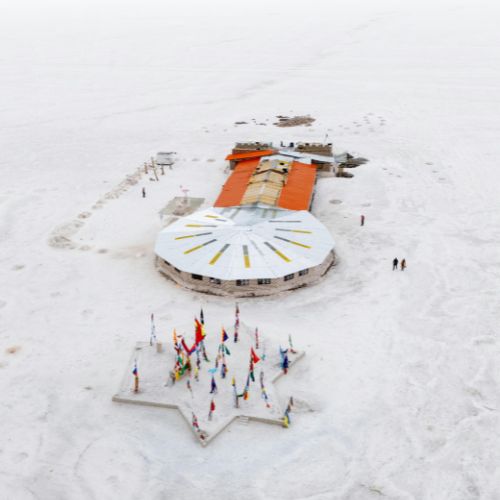The Salar de Uyuni, located in the southwest of Bolivia, in the Potosí department, is the largest salt desert in the world and has several access points that adapt to different routes and travel styles. The most popular is the city of Uyuni, the main operations base, which can be reached by plane from La Paz or by bus and train from Oruro and Potosí, offering a wide range of agencies, hotels, and tourist services. Very close is Colchani, only 20 minutes away, ideal for observing artisanal salt production and purchasing handicrafts, and is also a direct entry point to the salt flats. From San Pedro de Atacama, in Chile, it is possible to access via multi-day tours that cross highland landscapes, volcanoes, and lagoons before reaching the salt flats. La Paz is also a key point, with direct flights and buses to Uyuni, while Oruro and Potosí offer complementary access options such as the Oruro Carnival or the Cerro Rico mines.
Uyuni City (Bolivia) – Main Access: This is the most popular gateway and the main base of operations for tours to the salt flats. You can arrive by Plane: From La Paz there are direct 1-hour flights, Bus: From La Paz, Oruro, or Potosí (8 to 10 hours), and Train: From Oruro, with stops in various towns and nearby attractions such as the Train Cemetery, Archaeological Museum, and local market.
Colchani – Direct Entrance to the Salt Flats: Only 20 minutes from Uyuni, on the edge of the salt flats. You can arrive via tours from Uyuni or private transport. Here you can see artisanal salt production, visit workshops, and browse stores selling crafts made of salt. Many short routes begin here.
San Pedro de Atacama (Chile): Perfect for combining the Salar de Uyuni with the Atacama Desert and its highland lagoons. The tour departs from Santiago de Chile to Calama (by plane) and then by bus to San Pedro (1.5 hours). There are also direct tours to Uyuni lasting 3 or 4 days, crossing the border at Hito Cajón.
La Paz (Bolivia): Connects the capital with Uyuni by air or land. You can go by plane, with a direct flight to Uyuni (1 hour), or by bus, with an overnight journey lasting 10 to 12 hours. The advantage of going through La Paz is the possibility to combine the salt flats with attractions such as Lake Titicaca, the Valley of the Moon, and the Death Road.
Oruro and Potosí: Oruro: Ideal for travelers who want to include Bolivia’s most famous carnival and then continue to the salt flats by train or bus. Potosí: Allows combining the visit with the Cerro Rico mines and then traveling by bus to Uyuni (6–7 hours).
Full Day Tour: Lasts 1 day (approx. 8 to 10 hours), starting from Uyuni, allowing you to experience high-altitude landscapes and biodiversity, as well as unforgettable sunrises and sunsets on the salt flats.
2 or 3-Day Tours: With overnight stays in basic accommodations, shelters, or salt hotels. This tour allows you to see high-altitude landscapes and biodiversity, as well as unforgettable sunrises and sunsets on the salt flats.
Photography Routes: Usually lasting 1 to 3 days, customized according to the traveler’s interests. This tour focuses on capturing sunrises, sunsets, starry skies, and the mirror effect during the rainy season.



